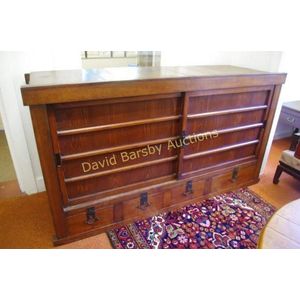Grand Edwardian Oak Cabinet with Eight Doors and Drawers
You must be a subscriber, and be logged in to view price and dealer details.
Subscribe Now to view actual auction price for this item
When you subscribe, you have the option of setting the currency in which to display prices to $Au, $US, $NZ or Stg.
- Edwardian - The Edwardian period of English furniture and decorative arts design is named for Edward VII (1841 ? 1910) who was King of the United Kingdom and the British Dominions and Emperor of India for the brief period from 1901 until his death in 1910. It follows the Victorian period, in turn was followed by the Art Nouveau and Art Deco styles. In Australia, designs of this period are also known as being in the Federation style.
- Oak - Native to Europe and England, oak has been used for joinery, furniture and building since the beginning of the medieval civilisation. It is a pale yellow in colour when freshly cut and darkens with age to a mid brown colour.
Oak as a furniture timber was superceded by walnut in the 17th century, and in the 18th century by mahogany,
Semi-fossilised bog oak is black in colour, and is found in peat bogs where the trees have fallen and been preserved from decay by the bog. It is used for jewellery and small carved trinkets.
Pollard oak is taken from an oak that has been regularly pollarded, that is the upper branches have been removed at the top of the trunk, result that new branches would appear, and over time the top would become ball-like. . When harvested and sawn, the timber displays a continuous surface of knotty circles. The timber was scarce and expensive and was used in more expensive pieces of furniture in the Regency and Victorian periods. - Proportions - Essentially, the size of the various parts of a piece of furniture in relation to the whole. Ideally, the proportions should be pleasing to the eye appearing neither top-heavy nor unbalanced and convenient for ordinary use.
- Pediment - The uppermost section of a tall usually double-heightened piece of cabinet furniture, surmounting the cornice. The pediment can take a variety of forms derived from the architecture of classical antiquity. A broken pediment is of triangular shape, however, the two raised sides do not meet at the apex but are 'broken' the gap between them often ornamented with an urn or finial. Swan-neck pediments are of similar form, although the uprights are gracefully arched, resembling a swan's neck. They are often found, for example, on longcase clocks.
This item has been included into following indexes:
Visually similar items

An Edwardian oak double wardrobe, matching the Next Lot, 148 x 222 x 57 cm

Japanese tanzu cabinet, with 2 sliding doors over 4 drawers, 191 cm wide, 63 cm deep, 106 cm high

Antique early 19th century mahogany press on chest, painted with S Fisher & Co store logo and stock list, approx 212 cm high, 135 cm wide, 62 cm deep

An antique Chinese dark lacquered pine storage chest with carved double bi fold doors over a three drawer cupboard base. Ornate brass handles, locks, hinges and fittings. Height 176 cm. Width 128 cm
